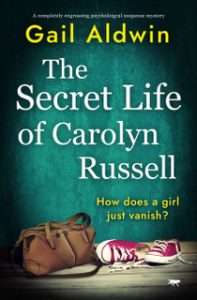Five Tips for Writing a Novel with two or more Viewpoint Characters
Five tips for writing a novel with two or more viewpoint characters
 One of the challenges of writing a successful novel is to nail the main character’s voice. By imagining ourselves into the lives of the characters we create, writers assume a fictional identity that enables us to develop a voice which reflects the internal and external dilemmas of the character. When using one viewpoint character, it is the work of the author to sustain the voice throughout the novel yet reflect developments in the character achieved from navigating the difficulties we throw at them. To achieve this balance is an accomplishment, so how much more problematic is it to write a novel with more than one viewpoint character? This was the question I posed when I began drafting the dual timeline novel The Secret Life of Carolyn Russell which includes the voice of a teenage schoolgirl in 1979 and a middle-aged journalist in 2014. Here are some of the strategies I used to keep the voices separate and consistent:
One of the challenges of writing a successful novel is to nail the main character’s voice. By imagining ourselves into the lives of the characters we create, writers assume a fictional identity that enables us to develop a voice which reflects the internal and external dilemmas of the character. When using one viewpoint character, it is the work of the author to sustain the voice throughout the novel yet reflect developments in the character achieved from navigating the difficulties we throw at them. To achieve this balance is an accomplishment, so how much more problematic is it to write a novel with more than one viewpoint character? This was the question I posed when I began drafting the dual timeline novel The Secret Life of Carolyn Russell which includes the voice of a teenage schoolgirl in 1979 and a middle-aged journalist in 2014. Here are some of the strategies I used to keep the voices separate and consistent:
- Create distinct characters
When juggling two or more viewpoint characters within one novel, it’s useful to make them very different from one another. In The Secret Life of Carolyn Russell, I was also playing around with timelines and this helped to separate the characters’ voices, particularly in the selection of vocabulary. These days, we hear about boyfriends being dumped, but back in the UK during the 1970s we referred to this experience as being chucked. It probably helped that I could draw on my own memories to develop Carolyn’s voice and I used research such as listening to BBC Radio Four’s My Teenage Diary. In creating the voice of the middle-aged journalist who investigates the cold case of Carolyn’s disappearance in 2014, I needed to develop a voice from the same small West Country town but add the experience of maturity.
- Naming characters
In previous novels, I’ve had to change my characters’ names during the redrafting process. This wasn’t necessarily because they were too similar, but in one case they actually rhymed. Character names have to be consistent with their date of birth and upbringing. Names may also reflect parental aspiration or class. When working with newly developed characters, I now think about what their name looks like on the page and this helps to adjust my thinking into the timeframe and experiences of each character. The three syllables in Carolyn worked well with the three syllables of Stephanie in drawing out the similarities and differences in their early life and this helped to tune my thinking into the timeline and experiences of each character.
- Use distinguishable voices
Although Carolyn and Stephanie have the same background as they attended the same school (although in different year groups), Stephanie has the benefit of growing into an adult while Carolyn remains in the world of a teenager. To hold their separate voices in my head, I clicked into a mature voice for writing from Stephanie’s viewpoint and a younger voice for Carolyn. As a rule of thumb in developing characters’ voices, it’s best to use regional accents sparingly or not at all. You won’t find any West Country phrases in The Secret Life of Carolyn Russell.
- Different body language
Non-verbal cues are another way to separate characters. When nervous, you might find teenage Carolyn biting her nails while menopausal Stephanie suffers hot flushes at the most inconvenient times. By making the experiences of the characters visual, this is a good way to reinforce their differences and connect with their voices.
- Ways of writing
Another strategy for working with two viewpoint characters within one novel involved writing out each storyline separately from start to finish. This prevented the two voices from interfering with each other. Once the 1979 storyline was completed, I worked on the 2014 story. The next phase involved interweaving the two narratives. This had the added benefit of being able to withhold material from the characters while giving the reader a fuller picture. Careful placement of information added tension to the novel and built jeopardy.
I was delighted to receive the following endorsement for The Secret Life of Carolyn Russell from bestselling author Suzanne Goldring:
Using a keen ear to create the voices of a troubled teenager in 1979 and a frustrated mid-lifer in 2014, Aldwin captures the zeitgeist for each period with telling accuracy.
With Suzanne’s kind words ringing in my ears, I feel positive about the strategies I’ve used to capture two voices.
—
Novelist, poet and scriptwriter, Gail Aldwin has been writing for over a decade. Her first two coming-of-age novels were runners-up in the Dorchester Literary Festival Writing Prize 2020 and 2022. Gail was awarded a creative writing PhD in 2018 and still laughs whenever she’s called Doctor Gail. She has appeared at Bridport Literary Festival, Stockholm Writers Festival and the Mani Lit Fest in Greece. Her psychological suspense mystery The Secret Life of Carolyn Russell is published by Bloodhound Books. Gail splits her time between a tiny flat in South West London and a home overlooking water meadows in Dorset.
Gail is active on social media and loves connecting with readers and writers. Do get in touch.
Twitter: https://twitter.com/gailaldwin
Facebook: https://www.facebook.com/gailaldwinwriter/
Instagram: https://www.instagram.com/gailfaldwin/
Blog: https://gailaldwin.com
The Secret Life of Carolyn Russell
A true-crime podcaster investigates a decades-old suspected abduction, in this powerful psychological suspense novel.
 1979 Sixteen-year-old Carolyn Russell grows increasingly infatuated with her school mathematics teacher who is also giving her private lessons. Then she disappears.
1979 Sixteen-year-old Carolyn Russell grows increasingly infatuated with her school mathematics teacher who is also giving her private lessons. Then she disappears.
2014 Struggling journalist Stephanie Brett creates a true-crime podcast focused on the disappearance of Carolyn Russell. By digging deep into this mysterious cold case, her confidence and flagging career are boosted. But after she confronts the suspects—and talks to a potential witness—the leads dry up. However, Stephanie refuses to let the story rest . . .
Can a small-time journalist with a shoestring podcast really hope to reconstruct the ultimate fate of Carolyn Russell after all these years, or are some secrets best left buried?
‘Takes hold of the head and the heart and simply does not let go’ Jacquelyn Mitchard, No. 1 New York Times bestselling author of The Good Son
‘Captures the zeitgeist for each period with telling accuracy’ Suzanne Goldring, bestselling author of My Name is Eva
‘A rare and thrilling book that manages to be thoughtful and intelligent’ Joanna Barnard, author of Hush Little Baby
Amazon UK, Amazon US, Barnes & Noble
Category: How To and Tips























